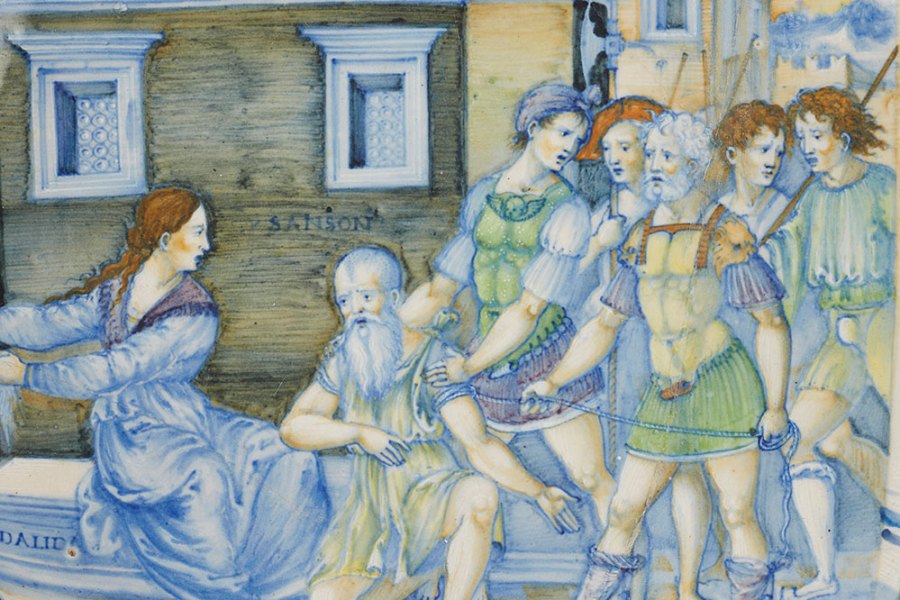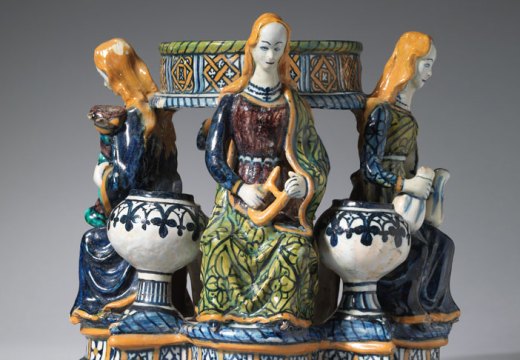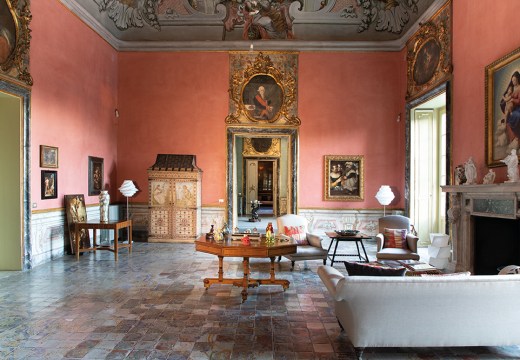From the March 2023 issue of Apollo. Preview and subscribe here.
In April 1490, Lorenzo de’ Medici wrote to thank Galeotto Malatesta, Lord of Rimini, for a present of what was almost certainly maiolica pottery: ‘They are perfect and much to my taste, so I appreciate them very much […] I value them more than if they were of silver, being very excellent and rare, as I say, and quite novel to us here.’ By the end of the 15th century, Italian maiolica – tin-glazed, colourfully painted wares – had become both an esteemed decorative art form and valuable diplomatic currency. Yet the roots of the medium can be traced back much further.
During the 13th century, the technique of tin-glazing, known in the Islamic world since about 800, spread through Italy. Tin oxide enabled the creation of an opaque white surface which provided a good base for painting. Early maiolica in northern and central Italy was decorated primarily with the purple-brown of manganese and the green of oxidised copper. Over the course of the 14th century, imported cobalt enabled potters to create vivid blues; later, yellow derived from antimony and a range of oranges from iron further added to the range of colours. The technique was expensive, relying as it did on imported tin. Paintings of the period, which depict these objects, testify to their prestige.

Italian maiolica trefolil bowl, attributed to the Patanazzi workshop (c. 1575–1600). Courtesy Sotheby’s
In around 1460, noting the fashion for iridescent obra de malica (Spanish for ‘Malaga wares’), a group of Italian potters learnt the Islamic method of applying metallic lustre. Gubbio and Deruta became significant centres for the production of this type of maiolica, but the technique spread fast through Italy and its practitioners became rapidly more ambitious.
By around 1500, potters in Faenza were making what became known as istoriato wares. Rather than abstract patterns or individual figures, artists executed elaborate polychrome scenes across the entire white surface of the vessels. The subjects – usually biblical, historical or mythological and often derived from contemporary prints or paintings – were accomplished with a degree of naturalism (including the use of perspective) that was unprecedented in pottery decoration. Istoriato wares were produced in small numbers. Yet, as the expert Timothy Wilson has noted, they nonetheless remained ‘for sixty years the apex of maiolica manufacture and the basis of its aspiration to be taken seriously as a Renaissance art form.’
Among the most accomplished istoriato painters was Nicola da Urbino (c. 1480–1540/47); his most significant commissions include one by Eleonora Gonzaga, Duchess of Urbino, in 1524 to create a service painted with scenes from Ovid’s Metamorphoses for her mother, Isabella d’Este. He and his son Guido Fontana (1490–1576) drew inspiration from prints of works by Urbino’s most famous artist, Raphael. Francesco Xanto Avelli, born in the Veneto town of Rovigo in the late 1480s, also made his name in Urbino with his distinctive muscular figures, while Giorgio Andreoli of Gubbio (1465/70–1553) was known for his humanist subjects. The art historian J.V.G. Mallet also identified the In Castel Durante Painter, the Master of the Apollo Basin, the Milan Marsyas Painter and the Painter of the Coal Mine Service. The istoriato wares were so highly regarded that the pope encouraged cardinals to dine off them. By the end of the 16th century, the istoriato style had degenerated – in part because, after the Council of Trent (1545–63) ushered in the Counter-Reformation, the prevailing mood turned against mythological subjects.
Istoriato wares lead the market today, but the best pieces are extremely rare. In October 2021, Lyon & Turnbull mounted a sale from the contents of Lowood House in the Scottish Borders. An armorial dish from the workshop of Nicola da Urbino (c. 1520–23) was cautiously estimated at £80,000–£120,000, before being chased to a record-breaking £1.3m, including fees. This beat the previous record of €1.2m for a work of maiolica set at Christie’s Paris in 2009 for an armorial dish of c. 1525 from the same workshop.

Dish depicting Samson and Delilah (c. 1520–23), attributed to Nicola da Urbino. Lyon & Turnbull, Edinburgh, £1.3m
Matilda Burn, a specialist in European ceramics and glass at Christie’s, explains that while Nicola da Urbino’s hand is distinguishable by scholars, it is hard to provide definitive attributions. This is why Francesco Xanto Avelli is ‘particularly appealing to collectors’ – he signed and dated so many of his works. A plate made by Xanto in 1539, late in his career, fetched £88,200 last September at Christie’s London, against a £60,000–£120,000 estimate. Earlier pieces ‘would be [worth] quite a lot more,’ Burn says.
Other notable auction results for pieces from Urbino, both at Sotheby’s London, include the sale of a large maiolica footed dish, with a beautiful scene of Theseus defending Hippodamia attributed to the Painter of the Apollo Basin, dated 1533; it achieved £257,000 in 2016 (estimate £30,000–£40,000). In 2017, a piatto da pompa (‘pomp plate’) of c. 1550–60, probably from the Fontana workshop, sold for £224,750 against an ambitious estimate of £200,000–£300,000.
Justin Raccanello and Camille Leprince, leading dealers in the field of Renaissance maiolica, will be showing an extensive display of istoriato wares with the emphasis on female patronage at TEFAF Maastricht in collaboration with Christophe de Quénetain. One recent discovery is a pair of elaborate trefoil bowls, attributed to the Urbino workshop of Francesco Patanazzi, which sold at Sotheby’s in October last year for €226,800. Raccanello has since established that one of them was commissioned in 1599 by the sister of the duke of Urbino, Isabella della Rovere. His prize piece at Maastricht is an early (c. 1525) dish painted by Nicola da Urbino, depicting the story of Europa and the bull, with the coat of arms of the Calini family. The asking price is €1.5m. Raccanello sells mainly to British, American and French museums and a few experienced collectors, predominantly in the United States and Europe, who combine interests in ceramics, glass and Old Master paintings.
Istoriato wares – and, perhaps to a lesser extent, earlier lustreware from Gubbio and Deruta – have always been sought after. Yet between about 1870 and 1930, collectors shifted their focus to the first, medieval phase of maiolica production. Scholarly enthusiasts such as Charles Fairfax Murray, Henry Wallis and Wilhelm von Bode helped to create substantial collections of early pottery that eventually contributed to the outstanding holdings in the V&A, the Met and Berlin State Museums. Matthew Reeves, director at London dealership Sam Fogg, says, ‘For these collectors this was the holy grail; the birth of maiolica as we know it.’
Today, this material is undervalued. In 2017, Sam Fogg presented an exhibition of 43 fine pieces from before 1500, tracing the evolution of Italian maiolica from its archaic origins. The dealership has available an early Orvieto two-colour bowl decorated with a broad leaf design (c. 1420; price on application). ‘Of extreme rarity’, it has ‘a very imposing scale’ and represents an astonishing survivor of a vital tradition.
From the March 2023 issue of Apollo. Preview and subscribe here.
Unlimited access from just $16 every 3 months
Subscribe to get unlimited and exclusive access to the top art stories, interviews and exhibition reviews.














![Masterpiece [Re]discovery 2022. Photo: Ben Fisher Photography, courtesy of Masterpiece London](http://www.apollo-magazine.com/wp-content/uploads/2022/07/MPL2022_4263.jpg)
It’s time for the government of London to return to its rightful home